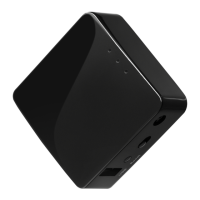
Do you have a question about the GL-INET GL-MT300N-V2 Series and is the answer not in the manual?
| RAM | 128MB DDR2 |
|---|---|
| Flash Storage | 16MB |
| WiFi Standard | 802.11b/g/n |
| WiFi Speed | 300Mbps |
| USB Ports | 1 x USB 2.0 |
| Power Supply | 5V/2A |
| Dimensions | 58 x 58 x 25 mm |
| Operating System | OpenWrt |
| Processor | MediaTek MT7628NN |
| Ethernet Ports | 2 x 10/100Mbps |
Connect the router to a power source using a compatible 5V/1A power adapter.
Connect your device to the router via Ethernet cable or Wi-Fi.
Access the router's web interface via http://192.168.8.1 for initial setup.
Connect to the internet using an Ethernet cable.
Extend existing Wi-Fi coverage by connecting to another wireless network.
Connect to the internet using a USB 3G/4G modem.
Share your smartphone's internet connection with the router via USB.
Configure SSID, security, password, channel, speed, and transmit power for the Wi-Fi.
View and manage connected devices, including blocking unwanted clients.
Automatically check for and download new firmware versions.
Upload firmware files directly to the router.
Configure scheduled automatic firmware updates.
Configure rules to allow remote access to internal services.
Specify ports to be open for external access to router services.
Expose a specific device to the internet for inbound traffic redirection.
Configure and use OpenVPN for secure remote access and browsing.
Configure and use WireGuard for fast and modern VPN connections.
Configure and use Shadowsocks for secure proxy connections.
Define routing policies to control which traffic uses the VPN.
Manage and install OpenWrt packages and extensions on the router.
Configure sharing of external storage devices connected to the router.
Set up DDNS for remote access to the router via a domain name.
Configure a captive portal for guest Wi-Fi access.
Change the password for router web interface access.
Configure the router's local IP address for network access.
Set the router's time zone for accurate logs and schedules.
Clone a client's MAC address to the router for network access.
Configure DNS servers for privacy and security.
Configure the mode switch button's function.
Choose the router's operational mode (Router, AP, Extender, WDS).
Reset the router to factory settings, erasing all data.
Access the default OpenWrt web interface for advanced settings.